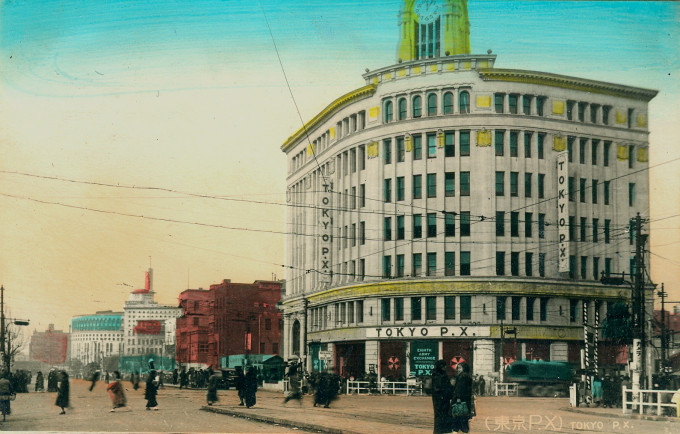
Ginza Crossing, c. 1945. The district suffered great damage during a May 1945 firebombing of Tokyo. In the immediate aftermath of the Pacific War, Ginza remained a burnt-out shell of its former self, but would quickly be rebuilt during the Occupation. It appears macabre that postcards of Tokyo’s wartime destruction were sold as “souvenirs” immediately after the war. But, vendors did great business selling them to Occupation troops who mailed them home to the US to show family and friends what war hath wrought.
See also:
Ginza Crossing, c. 1910-1940
Hattori (Wako) Building, Ginza
Matsuya Department Store, Ginza
Tokyo “Black Markets”, 1945
St. Luke’s International Hospital, Tsukiji, c. 1945-50
“[December 21, 1945:] At night, driving past General MacArthur’s Headquarters, saw a huge ‘Merry Christmas’ sign go ablaze with a thousand lights. The sign cast light over the outer wall of the Imperial Palace, and was reflected in the rippling water of the wide moat. I thought of the symbolism inherent in this American light thrown on the darkest Japanese institution; on the debris piled up like monuments in lots which once contained the heart of the Japanese financial empire; on the steady procession of U.S. Army jeeps and trucks; and on the shivering Japanese girls soliciting GI customers at the entrance to Hibiya Park, ‘Very good, Joe, very cheap.’
“I thought of this great city, which today contains little but rubble and an obstinate will to live, of a city in which I could travel for ten and twenty and thirty blocks at a time and see nothing but shattered brick, a few chimneys, and a score or two of abandoned safes that had crashed down through the floors of burning buildings.
“The men and. women who had once made Tokyo the world’s third largest city have now gone into the countryside, or moved into the few surviving buildings, three and four families to a room And countless thousands have built shacks from rusty sheets of iron, or moved into the railroad and subway stations. In the morning, one can see smoke rising from what looks like a pile of junk and iron, but in reality is a home. Men still go to work in unbelievably crowded offices, and huddle close to the small warmth given out by a charcoal brazier.
Ginza Crossing, c. 1945, looking northwest toward Kyobashi. The Wako department store is left; the burned-out shell of the Mitsukoshi Ginza department store is right. The Dai-Ichi Sogo building is in the distance.
“This city now is a world of scarcity in which every nail, every rag, and even a tangerine peel has a market value. A cupful of rice, three cigarettes, or four matches are all a day’s ration. Men pick every grain of rice out of their tin lunch boxes; there are too few to be wasted. And on a sunny day men hang out of windows and try to light their cigarettes with magnifying glasses. It can be done when there is no choice. Like the rest of Japan, Tokyo is a world of illicit trading. Close to each of its railroad stations, in lots made vacant by bombs, there are now black markets, with thousands haggling over the price of a long-dead fish, apples, rice or chipped china.
Ginza Crossing, 1945. At center is the Wako department store. Damaged by firebombing in May, 1945 it would be quickly repaired and reopened early in the Occupation as the Tokyo PX (post exchange) for occupation troops.
“On the Ginza, once the show street of Tokyo, the big show now is in the windows of U.S. Army Post Exchanges. Here fascinated crowds stare at GI sweaters, towels, battle jackets, and sturdy shoes made of real leather, and hungry kids and young women beg for gum and chocolate and peanuts from soldiers waiting in line. Some day, if the city planners have their way, the Ginza will be a compound of the Atlantic City boardwalk and Chicago’s Merchandise Mart.
“Right now its pitted, dusty length is lined with dead buildings and piles of rubbish. Some of the department stores have bravely resumed business in the lower two or three floors, but the floors are covered with rubble, and the showcases are filled with cheap crockery and worthless junk. The stories above are nothing but concrete frames, still black where the flames had licked them.”
– Japan Diary, by Mark Gayn, 1948




